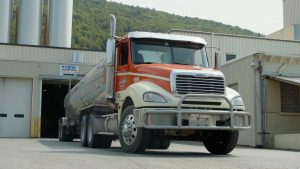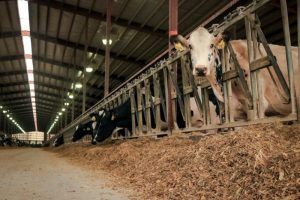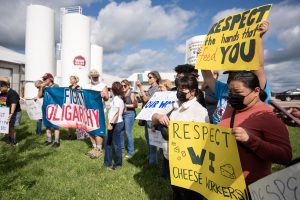
FORT MORGAN — The necklace attached to No. 36911 tracks her every move.
The black-and-white Holstein, backed up to a milking machine on a hot June day in a breezy barn, is on Bluetooth, just like the rest of the 4,500 dairy cows at Quail Ridge Dairy southeast of Fort Morgan.
The wireless transponder dangling from a canvas collar around her neck pings computers and sensors all over the farm, uploading data about how much milk she contributed to the dairy operation, what time she showed up to the milking barn and if she has a fever.

A quick swipe of a wand near her collar would let dairy owner Mary Kraft know whether No. 36911 was due for a vaccination or needed a pregnancy check.
And when the cow walks under an archway on her way out of the milking barn, a sensor above her head can tell whether she is due for a pedicure, setting in motion a series of gate switches that separate this cow from all the rest. She goes to the hoof trimmer; her friends go back to eating silage in the barn.
This is high-tech milk production on the rolling, windy plains northeast of Denver. Kraft’s “Bluetooth cows,” along with their top-notch genetics, are the high-efficiency reasons that Colorado has far fewer dairy farms today than it did three decades ago but more cows producing milk for the state and beyond.
About 25 years ago, when Kraft was in high school, her parents had 600 dairy cows. She and her husband, Chris, now have 6,000 between Quail Ridge and its sister operation, Badger Creek, just down the county road.
In 1996, Colorado had 429 dairy farms and 82,000 cows. Today, there are fewer than 90 dairies but 206,000 cows. And, Kraft said, the average cow produces double the milk as a cow in 1996.
Computers flag cow fevers, low milk output
Kraft is always eager to educate urban folks about dairy farming, particularly to counter what she sees as a growing anti-milk culture. Just because almond milk, oat milk and coconut milk are white, she says, doesn’t make them as good for you as cow’s milk. “If you’re going to have high-quality protein, you want the real McCoy,” she said. “That’s what I would go for.”
She opens conversations by saying that her “cows are on Bluetooth.” It, of course, grabs attention.
Her dairy cows wear their transponder necklaces their whole lives — as they munch feed, meander from the feeding barns to the milking barns three times each day, and sleep in their recycled bedding made of composted manure. The data feeds into an app on Kraft’s iPhone run by a company called VAS, or Valley Agricultural Software, and she can scroll through dozens of screens of information on milk output and health stats.

The dairy runs three milking shifts each day, at 6 a.m., 2 p.m. and 10 p.m., and every cow gets milked three times every day. The most aggressive cows, the high-achievers, are at the gate by 6 a.m. and the first to file through a series of pressure gates that gently prod them forward.
“These guys are creatures of habit. What they like to do is hang out and chew their cud and hang out with their neighbors,” said Kraft during a recent tour of her dairy. “They also know what time it is. Half of them will be standing at the gate saying, ‘OK people, it’s 6 o’clock. Get here.’ They are the assertive ones. The others are hanging behind, eating.”
Kraft knows thanks to the wireless transponders that her cows arrive at their milking machine almost at the same exact minute each day. “If she is here at 8:07 a.m., we can look at 8:07 every day and she’s going to be within two minutes of that,” Kraft said.

As they enter the milking barn, the cows move single file down an aisle of milking machines and turn one by one into stalls, 50 on each side of the barn. The seamless flow makes it look like the dairy cows are trained to line up in a perfect row, but in reality, each one is looking for its own space, as cows naturally do, and is prompted to file into a slender stall by a bar that shifts and creates an opening for its head.
Then eight workers zip past the tail-end of the cows — one with an antiseptic spray that stays on their udders for 30 seconds, another to squeeze a drop of milk out of each of four teats and make sure the cow’s udder doesn’t feel hot, and a third with a clean towel for each cow. Then the crew hooks up each cow’s milking machine, a spider-looking contraption that milks all four teats at once.
It takes about four and a half minutes of milking until the cow’s milk output slows and the machine automatically pops off their udder.
A computer on each milking stall records how much the cow gave — 3.5 gallons per milking is pretty average. If a cow’s machine pops off after just half a gallon, the computer flashes an alert. And if the milk comes out at 103 degrees and not at the standard body temperature of 101 degrees, the computer flags that too.
A cow with a fever would get routed by sensors to another corral and sent for a veterinarian check. This means the cow can get treated for pneumonia, mastitis or an inflamed foot before it gets too serious to cure. That’s a huge improvement from the pre-tech days when farmers were unlikely to detect a fever until their cow was too sick to move from the feeding barn to the milking barn.
Even the milk tanks at Kraft Family Dairies are “smart.”
Once they are filled with milk, which has been cooled from 101 degrees to 38 degrees in a 5 minute process that involves a series of pipes, the tanks notify the dairy cooperative that they’re ready for someone to empty them. The notification sends a semi truck to the dairy to empty the tank and drive the milk back to the coop, where it’s sold to become cheese, yogurt and milk shipped to grocery stores to restaurants, including Starbucks.
Bluetooth data separates high-achievers from the rest
The Bluetooth technology has revolutionized dairy farming, allowing Kraft to group cows into cohorts based on their milk production and maximize milk output.
She compares it to the way schools group together high-achievers and those who might need more help, which in the barns, means better nutrition.

What the cows eat comes straight from the farm’s “kitchen,” a row of giant stalls of ingredients — corn silage, hay silage, cotton seeds left over from clothing production, leftovers from breweries, and dried bakery waste, like crunched-up Fritos. All of it is measured and mixed like a giant batch of cookies by a truck that weighs scoops of each ingredient and stirs it together with a giant mixer.
“We feed them like they are elite athletes,” Kraft said.
The dairy also groups cows by where they are in their pregnancy and “dry period,” which is the two months or so before they give birth. Each cow is artificially inseminated and has a calf about every 14 months, or about three or four in their lifetime. The calves are bottle-fed from birth, and the cows return to the milking machines.
A calf needs to drink about a gallon of milk each day, but a dairy cow can produce about 10 gallons, or 80 to 110 pounds, per day as long as it keeps getting milked. And cows, like all mammals, only produce milk if they have babies, which is why dairies strategically plan their cows’ pregnancies. While pregnant, a cow’s mammary tissue refreshes, which improves their milk production.
Male calves are sold to beef operations, while female calves grow up to join the dairy operation. Once a cow is done with her dairy career, which typically lasts until age 6 but sometimes up to 13 years, she is sold for meat.
“When they are finished with their milking life, we are not done with that animal,” Kraft said. “She is going to go on to produce high-quality protein. She is going to be a hamburger or something like that.”
Animal cruelty measure would make dairy farming more dangerous
Like many farmers and ranchers in the state, Kraft said she feels under attack, always on the defensive about how food is produced. A proposed ballot initiative, recently struck down by the state Supreme Court, would have asked voters to make common farming practices illegal under an expanded animal cruelty law.

The proposal, Initiative 16, would have outlawed artificial insemination, defining it as a sex act with an animal. The measure is dead for now, but Kraft still wonders what would happen if she had to impregnate all 6,000 of her cows with herd bulls. Working at the dairy would become far more dangerous, she said.
“We use technology so that we can advance,” she said, noting that milk from her dairy is shipped as far as China. “We’re quite a little economy here.”























